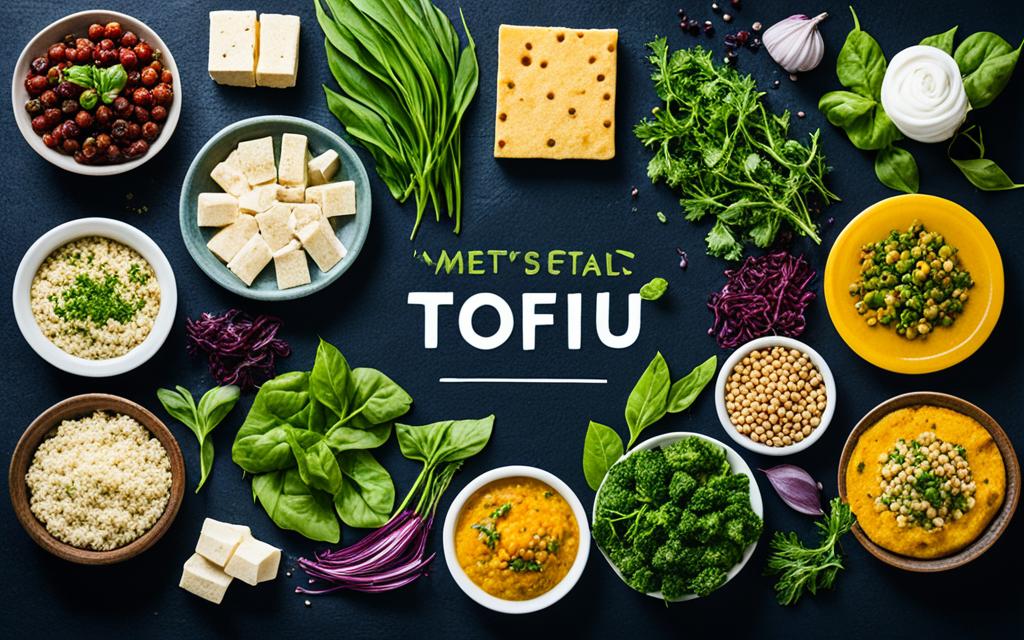In a world where plant-based eating is rapidly gaining momentum, vegetarian and vegan cooking has become more than just a culinary trend – it has evolved into a vibrant tapestry of flavors, textures, and cultural influences. From plant-based recipes and vegan meal ideas to meatless cooking and vegetarian comfort food, the possibilities for creating delicious and healthy vegan dishes are endless. In the realm of vegan cuisine, tofu stands out as a versatile and beloved ingredient that marries texture and taste to perfection.
Rooted in the culinary traditions of cultures around the globe, tofu has found its way into the hearts and mouths of both vegans and non-vegans alike. With its ability to absorb flavors and adapt to various cooking techniques, tofu offers a multitude of possibilities for creating easy vegetarian dishes, meat substitute recipes, and healthy vegan cooking. Whether you’re a seasoned vegan or just beginning to explore the world of plant-based eating, tofu is sure to elevate your culinary experience and delight your taste buds.
Throughout this article, we will take a deep dive into the world of tofu, exploring its versatility, cultural significance, nutritional benefits, and varied textures. We will also provide tips and tricks for vegetarian cooking, share delicious tofu recipes, and discuss the environmental and ethical advantages of incorporating tofu into your diet. By the end of this culinary journey, you will be equipped with the knowledge and inspiration to embrace the tapestry of flavors and textures in vegan cuisine.
Key Takeaways:
- Tofu is a versatile ingredient that enhances the taste and texture of vegan dishes.
- Vegetarian and vegan cooking offers endless possibilities for creating delicious and healthy meals.
- Tofu’s history, cultural significance, and nutritional benefits make it a staple in vegan cuisine.
- Exploring tofu’s varied textures and pairing it with other vegan ingredients expands culinary horizons.
- Incorporating tofu into your diet aligns with sustainability and ethical eating practices.
Exploring Tofu’s Versatility in Vegan Cooking
Tofu is a staple ingredient in vegan cooking due to its versatility and ability to absorb flavors. This section will delve into the history and cultural significance of tofu, tracing its origins back to ancient China and its spread throughout Asia and the rest of the world. It will also explore the impressive nutritional profile of tofu, highlighting its high protein content, low saturated fat levels, and various vitamins and minerals. Additionally, it will discuss the different textures of tofu, from silken to extra-firm, and how they can be used in a wide range of vegan recipes.
History and Cultural Significance
Tofu, also known as bean curd, has a rich history that dates back over 2,000 years in China. It is believed to have been first discovered during the Han Dynasty and quickly spread throughout Asia. Tofu’s cultural significance can be seen in its strong presence in various Asian cuisines, where it is celebrated as a versatile and nutritious ingredient.
“Tofu is a true culinary chameleon, adapting to the flavors and cooking styles of different cultures around the world.” – Chef Mei Lin
Tofu as a Nutritional Powerhouse
Tofu is renowned for its impressive nutritional profile, making it an excellent choice for those following a vegan or plant-based diet. It is a complete protein, containing all essential amino acids, and is also rich in iron, calcium, and magnesium. Additionally, tofu is low in saturated fat, cholesterol-free, and a good source of plant-based omega-3 fatty acids.
By incorporating tofu into their meals, individuals can boost their protein intake, support muscle growth and repair, and promote overall health and well-being.
Tofu’s Varied Textural Possibilities
One of the unique characteristics of tofu is its ability to take on various textures, ranging from soft and silky to firm and chewy. This versatility allows tofu to be used in a wide array of vegan recipes, from creamy dressings and sauces to crispy stir-fries and grilled dishes.
Here are some common types of tofu and their textural qualities:
| Type of Tofu | Texture | Best Uses |
|---|---|---|
| Silken Tofu | Soft and smooth | Soups, smoothies, desserts |
| Soft Tofu | Tender and delicate | Scrambles, dips, custards |
| Firm Tofu | Sturdy and versatile | Stir-fries, grilled dishes, scrambles |
| Extra-Firm Tofu | Dense and chewy | Baked tofu, skewers, sandwiches |
Experimenting with different textures of tofu can add depth and variety to vegan dishes, catering to individual preferences and culinary creativity.
Vegetarian and Vegan Cooking
Vegetarian and vegan cooking is a vibrant and delicious way to embrace a plant-based lifestyle. By eliminating meat and animal products from our diets, we can experience a wide array of benefits for our health, the environment, and animal welfare. Whether you are vegetarian or vegan, this section will provide you with valuable tips and tricks to enhance your culinary skills and create satisfying and flavorful plant-based meals.
One of the key advantages of vegetarian and vegan cooking is the positive impact it has on our health. Studies have shown that plant-based diets can help reduce the risk of chronic diseases, such as heart disease, diabetes, and certain types of cancer. By focusing on nutrient-rich plant foods like fruits, vegetables, whole grains, legumes, and nuts, we can nourish our bodies with the essential vitamins, minerals, and fiber they need to thrive.
Another significant benefit of vegetarian and vegan cooking is its contribution to environmental sustainability. Livestock farming is a major contributor to greenhouse gas emissions, deforestation, and water pollution. By choosing plant-based alternatives, we can reduce our carbon footprint and help mitigate climate change. Additionally, plant-based diets require fewer resources, such as water and land, making them more sustainable and ecologically friendly.
Vegan cooking also aligns with ethical considerations, as it avoids the exploitation and suffering of animals. By opting for vegetarian substitutes, such as tofu, tempeh, and seitan, we can recreate a wide range of flavors and textures without compromising on taste or nutrients. These versatile ingredients can be used in various dishes, from hearty stews and stir-fries to delicious burgers and desserts.
When it comes to cooking vegetarian and vegan meals, creativity and experimentation are key. Seemingly simple ingredient swaps, such as using plant-based milk instead of dairy milk or incorporating tofu instead of meat in a stir-fry, can transform a mundane dish into a culinary masterpiece. There are endless possibilities to explore, from exploring different cooking techniques to discovering new flavor combinations and seasonings.
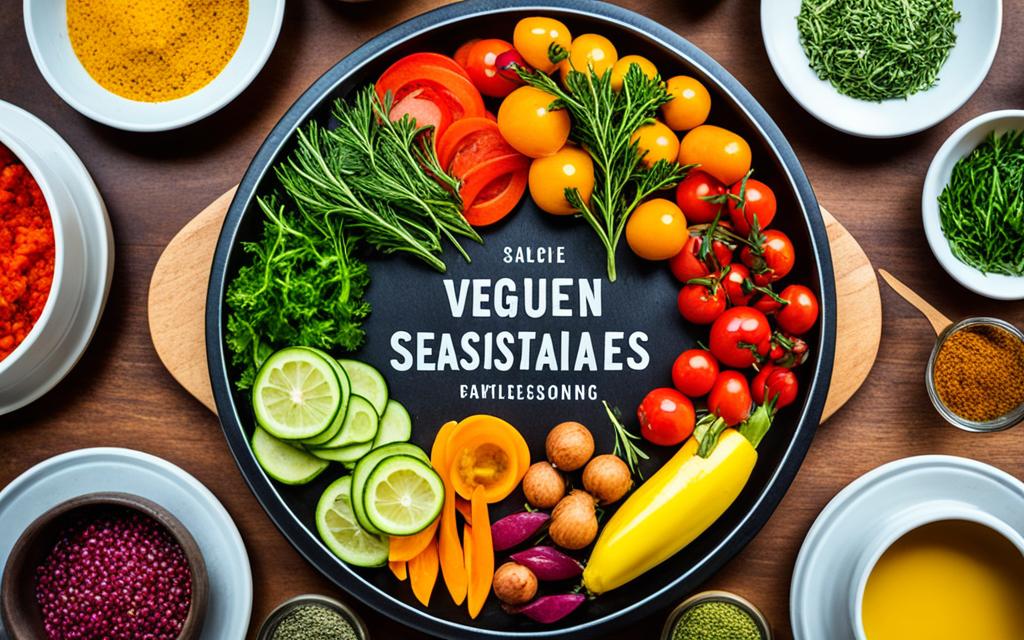
Meat substitutes, such as tofu and tempeh, are excellent alternatives that offer a great source of protein and a variety of textures. Tofu, in particular, is a versatile and nutritious ingredient that can be marinated, baked, stir-fried, or grilled to create delicious plant-based meals. With its ability to absorb flavors and mimic the texture of meat, tofu can satisfy even the most fervent meat lover’s cravings.
Experimenting with different plant-based ingredients, such as a wide range of fruits, vegetables, grains, legumes, and spices, is also crucial in vegetarian and vegan cooking. These ingredients provide an abundance of flavors, colors, and textures that can elevate your dishes to new heights. Additionally, exploring various cooking techniques, such as roasting, steaming, or sautéing, can bring out the natural flavors and enhance the overall taste of your plant-based creations.
By incorporating these tips and tricks into your vegetarian and vegan cooking, you can create a diverse and satisfying menu that will nourish your body, please your taste buds, and contribute to a more sustainable and ethical way of living. Embrace plant-based eating and discover the joys of vegetarian and vegan cooking today!
Highlighting International Tofu Delicacies
Tofu, a versatile ingredient, takes center stage in various cuisines around the world. Asian culinary traditions, in particular, have embraced tofu and showcased its myriad flavors and cooking techniques. This section explores traditional tofu dishes from countries like China, Japan, Korea, and Thailand, offering a glimpse into the rich tapestry of Asian tofu recipes and their unique characteristics. Additionally, contemporary tofu innovations from different parts of the world will be highlighted, as chefs and home cooks continue to experiment with tofu to create innovative and delicious dishes.
Tofu in Asian Culinary Traditions
Asian countries have long revered tofu as a staple ingredient, using it as a canvas to showcase their rich culinary traditions. China, the birthplace of tofu, offers an extensive array of tofu recipes, ranging from silken tofu soups to stir-fried tofu dishes. Japan, known for its delicate and refined cuisine, celebrates tofu through dishes like agedashi tofu, where deep-fried tofu is paired with a savory dashi-based sauce. In Korea, tofu is transformed into soft and custard-like soondubu jjigae, a spicy stew that tantalizes the taste buds. Meanwhile, in Thailand, tofu takes on a central role in dishes like pad thai and green curry, adding a delightful creaminess and balance of flavors.
Contemporary Tofu Innovations Around the World
As tofu gains popularity worldwide, chefs and home cooks outside of Asia are incorporating it into their dishes with creative twists. From tofu scrambles as a vegan alternative to scrambled eggs to tofu burgers that rival their meat counterparts, contemporary tofu innovations demonstrate the versatility of this plant-based ingredient. Tofu is also used in desserts, such as tofu cheesecakes and chocolate mousse, showcasing its ability to lend a creamy texture and enhance the flavors of sweet treats. These global tofu delicacies reflect the ever-evolving culinary landscape and the endless possibilities of tofu as an ingredient.
The tantalizing image above captures the vibrant and diverse flavors found in international tofu delicacies. The golden brown tofu stir-fry along with the colorful assortment of fresh vegetables and aromatic herbs perfectly exemplify the harmonious partnership of textures and flavors that tofu brings to a dish.
Crafting the Perfect Tofu Dish
When it comes to crafting the perfect tofu dish, knowing the right cooking techniques and flavoring options is key. Tofu’s versatility allows for various cooking methods, such as stir-frying, baking, and marinating, which can yield different textures and flavors. Whether you’re aiming for crispy tofu or seeking to enhance the taste through seasonings and sauces, these tips will help you create flavorful tofu dishes that will satisfy even the most discerning palate.
One popular method is stir-frying, which allows tofu to develop a crispy exterior while retaining a soft and creamy interior. By using high heat and a small amount of oil, you can achieve a deliciously crispy texture in your tofu stir-fries. Another technique is baking, which results in a firm and chewy texture. Simply marinate the tofu in your favorite marinade, place it on a baking sheet, and bake until golden brown.
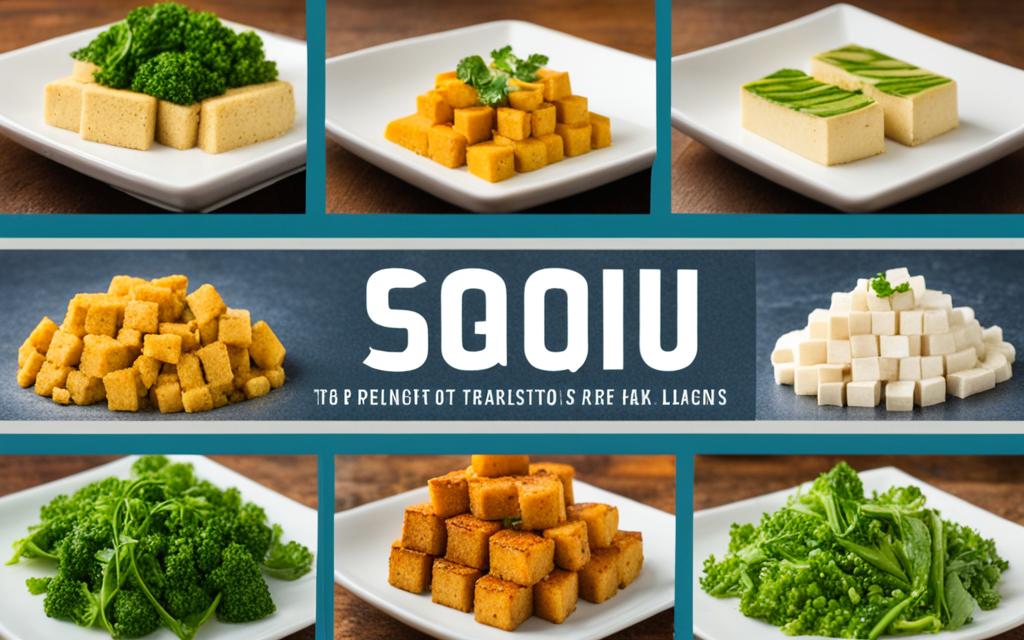
Marinating tofu is another effective way to infuse it with flavor. By soaking tofu in a marinade of your choice, you can add depth and complexity to its taste. Experiment with different marinade combinations, such as soy sauce, garlic, ginger, and spices, to create unique flavor profiles.
To achieve crispy tofu, it’s important to press and drain the tofu before cooking. This removes excess moisture and allows the tofu to crisp up nicely. Once pressed, you can coat the tofu in cornstarch or breadcrumbs and pan-fry it until golden and crispy.
Lastly, seasoning and saucing tofu can make a world of difference in its taste. Consider using flavorful ingredients like tamari, miso paste, nutritional yeast, or sesame oil to enhance the umami flavors of tofu. You can also experiment with various spices, herbs, and chili peppers to add a kick of flavor.
By mastering the art of tofu cooking, you can create a wide range of delicious and flavorful plant-based dishes. From crispy stir-fries to savory baked tofu, the options are endless. So, start exploring different tofu cooking techniques, flavoring options, and recipes, and elevate your tofu dishes to new heights of taste and satisfaction.
The Environmental and Ethical Advantages of Tofu
Tofu offers numerous environmental and ethical advantages that make it an ideal choice for conscious eaters. Not only is tofu a versatile and flavorful ingredient, but it also has a significantly lower environmental impact compared to traditional meat sources.
Tofu’s Sustainability Benefits
When considering the environmental impact of tofu, the numbers are quite compelling. Tofu production produces considerably fewer greenhouse gas emissions compared to meat production, resulting in a lower carbon footprint. Additionally, tofu requires significantly less water and land resources to cultivate, reducing strain on our fragile ecosystems.
The sustainable nature of tofu production makes it an excellent choice for those looking to minimize their contribution to climate change and reduce their ecological footprint. By choosing tofu as a protein source, individuals can actively support sustainable eating practices that help protect the planet.
Tofu as a Staple in Ethical Vegan Diets
In addition to its environmental benefits, tofu aligns strongly with ethical vegan principles. Ethical considerations of reducing animal suffering are a cornerstone of vegan ethics, and choosing plant-based proteins like tofu directly supports this cause.
Tofu provides a sustainable and cruelty-free alternative to animal proteins, making it an essential staple in ethical vegan diets. It allows individuals to enjoy a protein-rich diet while actively contributing to the welfare of animals.
By opting for tofu as a sustainable protein source, individuals can make a positive impact on both the environment and animal welfare. Incorporating tofu into a well-rounded plant-based diet allows for a delicious and ethically conscious dining experience.
—
Culinary Techniques for Maximizing Flavor
Enhancing the flavor of tofu dishes is crucial in creating delicious and satisfying plant-based meals. By incorporating various flavor-boosting techniques and utilizing the right herb and spice combinations, you can elevate the taste of your tofu dishes to a whole new level. Here are some valuable cooking tips and ideas to enhance the flavors of your tofu creations.
1. Marinating Tofu: Marinating tofu is an excellent way to infuse it with delicious flavors. Choose marinades that include ingredients such as soy sauce, garlic, ginger, and citrus juices to add depth and complexity to the tofu. Let the tofu marinate for at least 30 minutes or up to overnight for maximum flavor absorption.
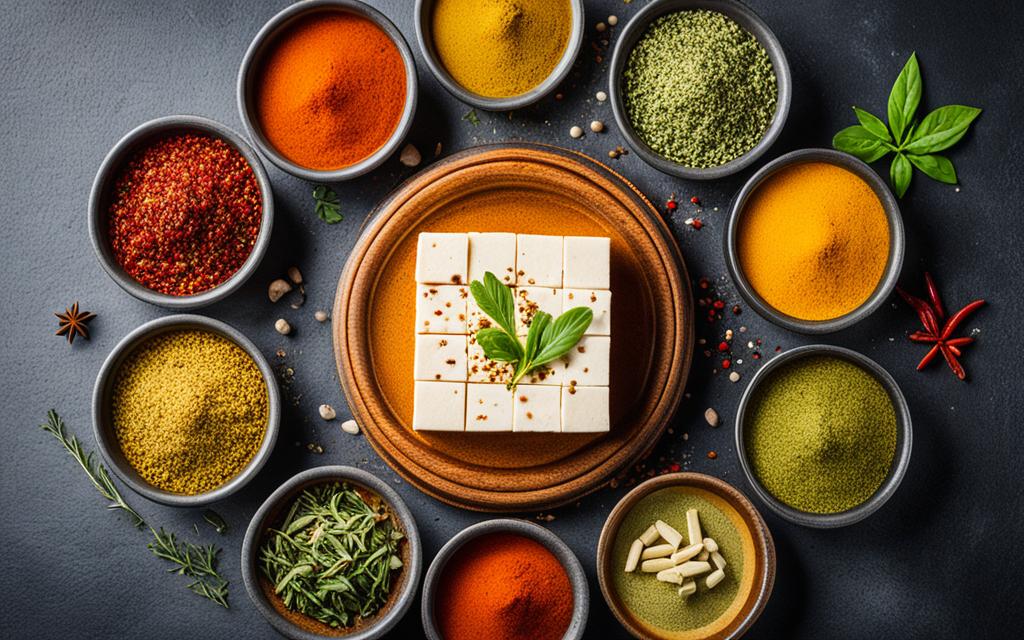
2. Herb and Spice Combinations: Experimenting with different herb and spice combinations can transform the flavor of your tofu dishes. Some popular options include:
- Italian-inspired: Basil, oregano, thyme, and garlic.
- Asian-inspired: Sesame oil, soy sauce, ginger, and chili flakes.
- Mexican-inspired: Cumin, chili powder, paprika, and coriander.
- Middle Eastern-inspired: Cinnamon, cumin, coriander, and turmeric.
3. Umami-Rich Ingredients: Umami, often referred to as the “fifth taste,” can add depth and savoriness to your tofu dishes. Incorporate umami-rich ingredients like mushrooms, miso paste, nutritional yeast, and seaweed to enhance the overall flavor profile of your dishes.
4. Toasting Spices: Toasting spices before using them can intensify their flavors and aromas. Simply heat a dry skillet over medium heat, add your desired whole spices (such as cumin seeds, coriander seeds, or fennel seeds), and toast them until fragrant, stirring occasionally. Once toasted, grind the spices and use them to season your tofu dishes.
By employing these flavor-boosting techniques, exploring various herb and spice combinations, and incorporating umami-rich ingredients into your tofu dishes, you can create delectable and memorable plant-based meals that will satisfy even the most discerning palates.
Tofu and Health: Aligning Culinary Pleasure with Well-being
When it comes to the health benefits of tofu, this versatile plant-based ingredient has a lot to offer. Incorporating tofu into a balanced vegan diet can contribute to overall well-being and provide valuable nutrients.
Diet and Disease Prevention
Tofu has been linked to numerous health benefits, including its potential to reduce the risk of various diseases. Studies have shown that tofu consumption is associated with a lower risk of heart disease, thanks to its ability to help regulate cholesterol levels. Additionally, the phytochemicals present in tofu have been found to exhibit anti-cancer properties, making it a valuable addition to a cancer-preventive diet. Furthermore, the high levels of calcium and isoflavones in tofu have shown promise in supporting bone health and reducing the risk of osteoporosis.
By including tofu in your diet, you can take proactive steps towards preventing diseases and promoting optimal health.
Tofu in Balanced Vegan Diets
As a source of plant-based protein, tofu plays a crucial role in meeting nutritional needs in vegan meal planning. Protein is an essential macronutrient that is necessary for building and repairing tissues, supporting immune function, and maintaining muscle mass. Tofu provides a complete amino acid profile, which makes it an excellent alternative to animal-based protein sources.
In addition to protein, tofu offers other vital nutrients, such as iron, calcium, and various vitamins. These nutrients are essential for overall health and can help prevent nutrient deficiencies commonly associated with strictly plant-based diets.
Whether you follow a vegan lifestyle or are simply looking to incorporate more plant-based options into your meals, incorporating tofu into your diet can help ensure a balanced and nutrient-rich eating plan.
Overall, the health benefits of tofu are numerous, ranging from disease prevention to supporting a well-rounded vegan diet. By embracing the culinary pleasure of tofu, you can not only enjoy delicious meals but also take proactive steps towards optimizing your well-being.
Pairing Tofu with Other Vegan Ingredients
Pairing tofu with other vegan ingredients can create perfect harmony in plant-based meals, adding flavor, texture, and nutritional diversity. When combined with a variety of vegetables, grains, legumes, and plant-based fats, tofu can elevate dishes to new levels of deliciousness and provide all the essential nutrients needed for a well-balanced vegan diet.
“Tofu’s neutral flavor and ability to absorb and complement other ingredients make it an excellent foundation for a wide range of flavor profiles and cuisines.”
When it comes to pairing tofu with vegetables, the possibilities are endless. You can sauté cubes of firm tofu with colorful bell peppers, broccoli, and zucchini, creating a vibrant and nutritious stir-fry. Alternatively, you can oven-roast extra-firm tofu alongside root vegetables like sweet potatoes and carrots, enhancing their natural sweetness and adding a delightful caramelization.
Grains are another great companion for tofu. Cooked quinoa, brown rice, or couscous can be mixed with marinated and grilled tofu slices, creating a hearty and satisfying grain bowl. The mild and creamy texture of tofu also pairs wonderfully with grains like barley or farro, adding a rich and velvety element to grain-based salads.
Legumes, such as chickpeas, lentils, and black beans, provide a protein boost when combined with tofu. You can create a wholesome and filling vegan chili by simmering tofu chunks with a medley of legumes, tomatoes, and aromatic spices. Or you can mash tofu with cooked chickpeas to make flavorful and protein-packed vegan falafel.
Incorporating plant-based fats like avocado, coconut milk, and nut butter into tofu recipes can enhance both the taste and nutritional profile. You can blend silken tofu with ripe avocados to create a creamy and nutritious vegan salad dressing or use coconut milk to make a luscious tofu-based curry. Adding a dollop of almond or peanut butter to a tofu and vegetable stir-fry can bring a satisfying richness and a hint of nutty flavor.
Combining tofu with other vegan ingredients doesn’t have to be complicated. Simple recipes like tofu and vegetable skewers on the grill or tofu and grain salads can be prepared in minutes and offer endless variations. By experimenting with different combinations, you can discover your favorite flavors and create a diverse repertoire of satisfying and nutritious plant-based dishes.
Remember, the key to successful pairing is to consider the flavors, textures, and nutritional benefits of each ingredient. Whether you’re sautéing, baking, or blending, incorporating complementary vegan ingredients alongside tofu ensures a well-rounded meal that is both delicious and nourishing.
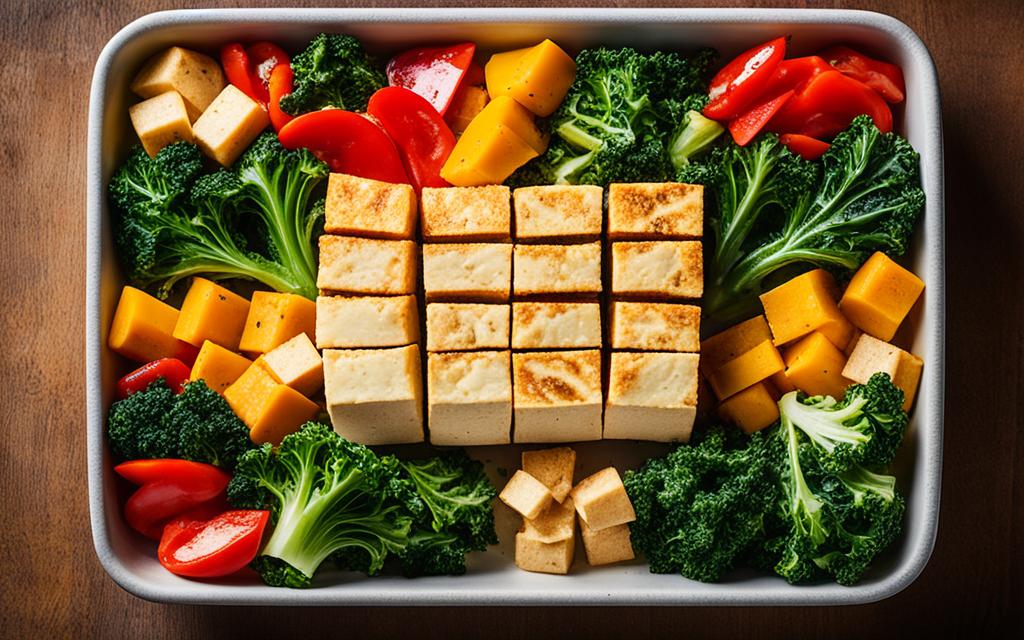
| Pairing | Ingredients | Recipe Ideas |
|---|---|---|
| Tofu and Vegetables | Broccoli, bell peppers, zucchini, sweet potatoes, carrots | Tofu-stir fry, oven-roasted tofu and vegetables |
| Tofu and Grains | Quinoa, brown rice, couscous, barley, farro | Tofu grain bowls, tofu grain salads |
| Tofu and Legumes | Chickpeas, lentils, black beans | Tofu chili, tofu falafel |
| Tofu and Plant-based Fats | Avocado, coconut milk, nut butter | Tofu-avocado dressing, tofu curry, nutty stir-fry |
Celebrating Plant-Based Diversity with Tofu
Tofu is celebrated in various cuisines around the world, showcasing the plant-based diversity it brings to different cultural dishes. From the rich flavors of Chinese cuisine to the delicate balance of Japanese dishes, tofu plays a vital role in global culinary traditions. Thai cuisine creatively combines tofu with spicy herbs and aromatic flavors, while Indian cuisine uses tofu as a versatile ingredient in curries and stews. The Mediterranean region also embraces tofu, incorporating it into vibrant salads and hearty dishes.
When exploring global cuisines with tofu, it’s fascinating to discover the unique cooking methods and flavor combinations associated with each culture. Chinese cuisine expertly combines tofu with soy sauce, ginger, and garlic, creating savory dishes that captivate the taste buds. Japanese recipes highlight the delicate nature of tofu, often serving it in simmered or grilled forms with soy-based sauces. Thai cuisine offers a harmonious blend of sweet, spicy, and tangy flavors, infusing tofu with bold Thai basil, lemongrass, and chilies.
India’s rich spices elevate tofu to new heights, with recipes featuring aromatic ingredients such as cumin, turmeric, and coriander. Meanwhile, Mediterranean cuisine embraces the natural simplicity of tofu, incorporating it into fresh salads alongside olives, tomatoes, and cucumbers, or serving it as a vegetarian alternative to classic dishes like moussaka.
| Global Cuisines with Tofu | Unique Flavors and Ingredients |
|---|---|
| Chinese Cuisine | Soy sauce, ginger, garlic |
| Japanese Cuisine | Soy-based sauces, simmering, grilling |
| Thai Cuisine | Thai basil, lemongrass, chilies |
| Indian Cuisine | Cumin, turmeric, coriander |
| Mediterranean Cuisine | Olives, tomatoes, cucumbers |
Additionally, this section will provide innovative recipes and ideas for incorporating tofu into a wide range of dishes. From unique tofu sushi rolls and crispy tofu nuggets to creamy tofu-based desserts, there are endless possibilities for creating delicious and exciting tofu creations. These recipes will encourage readers to think outside the box and experiment with tofu, unlocking their culinary creativity in the process.
By celebrating the global versatility of tofu, individuals can embrace the rich flavors and textures of plant-based cuisines from around the world. Whether recreating traditional favorites or exploring unique tofu-inspired dishes, tofu’s culinary potential knows no bounds. Take a leap into the vibrant world of global cuisines with tofu and discover the endless inspirations that await in your own kitchen.
The Future of Tofu in Global Vegan Cuisine
The future of tofu in global vegan cuisine is exciting, with ongoing advancements and innovations shaping its role in plant-based cooking. As the demand for vegetarian and vegan options continues to grow, tofu is at the forefront of creating flavorful and versatile dishes that appeal to a wide range of palates.
One of the key trends in tofu is the development of new varieties, flavors, and forms. From smoked tofu to spiced tofu cubes, chefs and food manufacturers are constantly exploring innovative ways to enhance the taste and texture of this plant-based protein. These new tofu options provide a wider range of choices for both seasoned vegans and those looking to incorporate more plant-based meals into their diets.
In addition, advancements in tofu production methods are improving sustainability and taste. With a focus on reducing environmental impact, tofu producers are implementing more efficient production techniques that utilize fewer resources and produce less waste. These advancements not only benefit the environment but also contribute to the overall quality and taste of tofu products.
Furthermore, tofu is increasingly becoming integrated into mainstream cooking. Chefs and home cooks alike are embracing its versatility and flavors, incorporating tofu into a variety of dishes beyond traditional Asian cuisine. From tofu scramble for a plant-based breakfast to grilled tofu burgers for a hearty dinner, tofu is finding its place in mainstream cooking, proving that it can be a delicious and satisfying alternative to animal-based proteins.
The image below showcases the exciting future of tofu in global vegan cuisine:
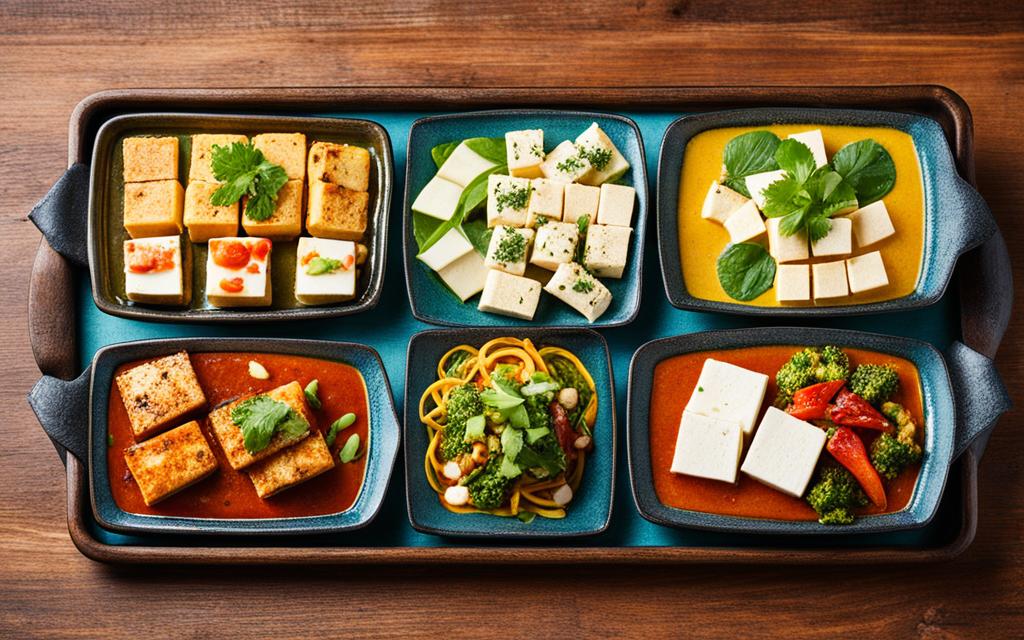
In conclusion, the future of tofu in global vegan cuisine looks promising. With trends focusing on new varieties and flavors, advancements in production methods, and increased integration into mainstream cooking, tofu is poised to play a leading role in the plant-based food revolution. Its versatility, sustainability, and delicious taste make it a cornerstone of future plant-based cuisine.
Conclusion
In conclusion, tofu is a versatile and flavorful ingredient that has carved a cherished place in vegan cuisine. Its ability to seamlessly marry texture and taste opens up a delightful world of culinary possibilities for plant-based cooking enthusiasts. From its rich history and cultural significance to its pivotal role in environmental sustainability and ethical veganism, tofu has become a cornerstone of the global vegan community.
By exploring tofu’s myriad textures, experimenting with innovative culinary techniques, and masterfully pairing it with other vegan ingredients, individuals can unlock their creativity and concoct an array of delectable tofu dishes. Whether it’s the delicate silkiness of silken tofu or the firm and chewy bite of extra-firm tofu, this legume-based protein offers a versatile canvas for culinary exploration.
The future of tofu shines bright in the realm of global vegan cuisine as chefs and home cooks alike continue to push the boundaries, developing new varieties, flavors, and forms to elevate its potential even further. By embracing tofu and incorporating it into one’s cooking repertoire, individuals embark on a delightful journey that celebrates the tapestry of flavors and textures found in vegan cuisine.
So, if you are ready to dive into the world of plant-based cooking, seize the opportunity to embrace tofu. Discover its versatility, savor its tantalizing taste profiles, and contribute to a more sustainable and compassionate way of eating. With tofu, the possibilities are endless, and the rewards are both culinary and ethical.
FAQ
What is tofu?
Is tofu suitable for vegetarians and vegans?
How can I use tofu in my cooking?
What are the different types of tofu?
Is tofu a healthy food option?
Can tofu be used as a meat substitute?
How can I add flavor to tofu?
Are there any health benefits to eating tofu?
Can tofu be used in desserts?
Where can I find tofu in the grocery store?
Source Links
- https://medium.com/four-pursuits-ventures/exploring-the-global-tapestry-of-vegan-delights-a-journey-through-diverse-vegan-cultures-and-eecb75e69869
- https://medium.com/@doddox/the-evolution-of-plant-based-cuisine-from-tofu-to-beyond-meat-7fd3be8e6531
- https://www.fukuoka-now.com/en/plant-based-saga02/
